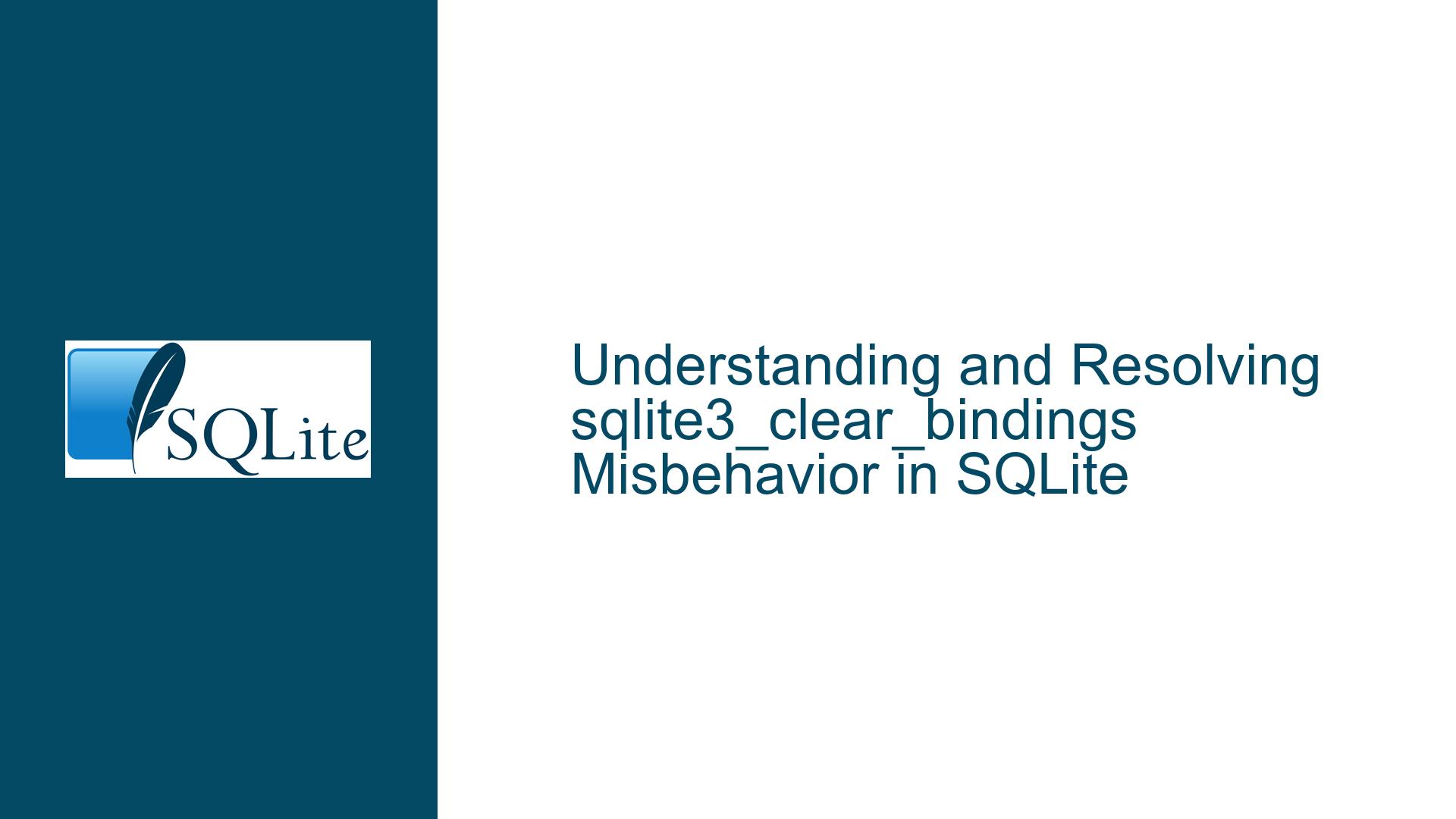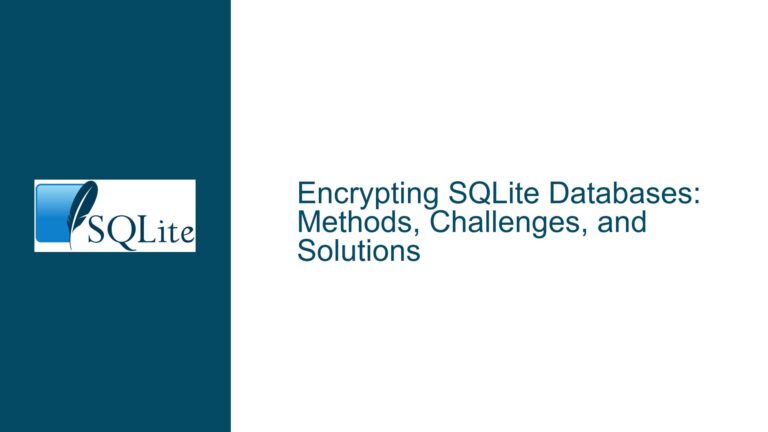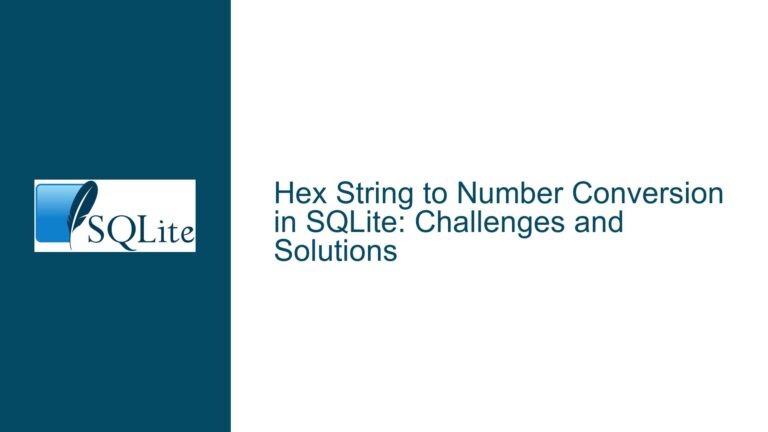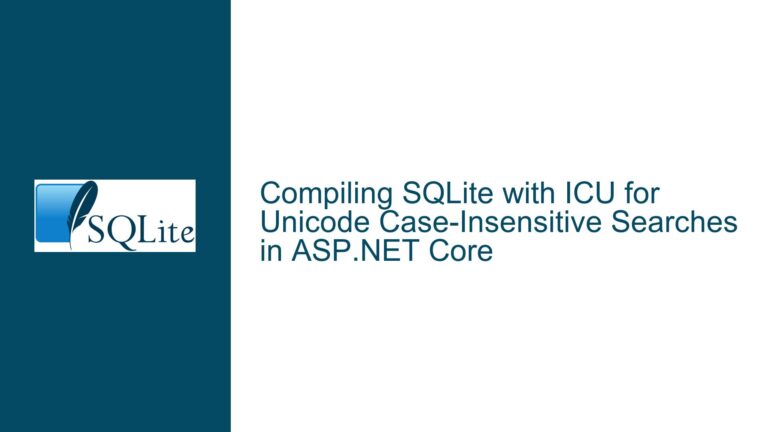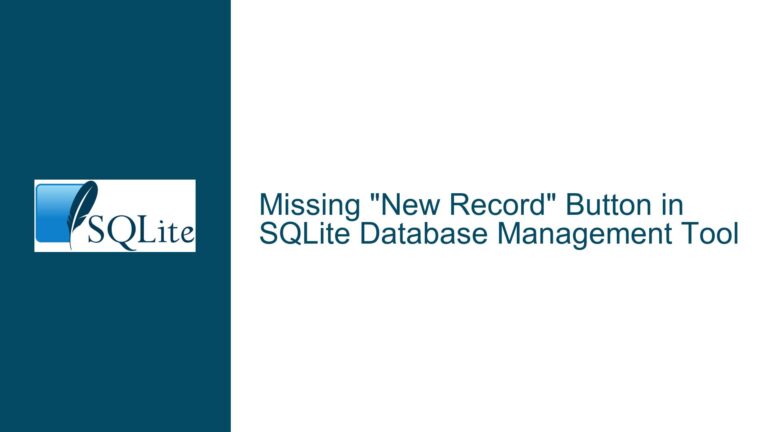and Resolving sqlite3_clear_bindings Misbehavior in SQLite
The Behavior of sqlite3_clear_bindings and Its Implications
The sqlite3_clear_bindings function in SQLite is designed to reset all the bindings on a prepared statement to NULL. This function is often used to ensure that no residual bindings from a previous execution interfere with the next execution of the statement. However, the function does not check whether the statement is currently in use (i.e., whether it is "busy" fetching rows) before clearing the bindings. This behavior has led to confusion and debate, particularly when compared to the sqlite3_bind_* functions, which do perform such checks and return SQLITE_MISUSE if the statement is busy.
The core of the issue lies in the expectation that sqlite3_clear_bindings should behave consistently with other binding-related functions, particularly in terms of error handling. When a statement is busy, attempting to modify its bindings can lead to undefined behavior or data corruption. The absence of a check in sqlite3_clear_bindings means that it silently proceeds with clearing the bindings, even if the statement is in an inappropriate state. This can mask programming errors, such as attempting to clear bindings while still processing rows from a query.
The debate also touches on the broader principles of API design, including consistency, backward compatibility, and the responsibility of the programmer. While some argue that sqlite3_clear_bindings should enforce the same checks as sqlite3_bind_* functions for consistency, others point out that such a change could break existing code that relies on the current behavior. Additionally, the function is often used in contexts where the statement is known to be in a safe state, making the check unnecessary.
The Role of sqlite3_reset and Proper Statement Lifecycle Management
A key aspect of this issue is the relationship between sqlite3_clear_bindings and sqlite3_reset. The sqlite3_reset function is used to reset a prepared statement so that it can be executed again. This function is critical for proper statement lifecycle management, as it ensures that the statement is no longer busy and is ready for re-execution. Importantly, sqlite3_reset does not clear the bindings; it only resets the statement’s execution state.
The typical sequence of operations for reusing a prepared statement involves calling sqlite3_reset to reset the statement, optionally calling sqlite3_clear_bindings to clear any existing bindings, and then re-binding the necessary values before calling sqlite3_step to execute the statement again. The optional nature of sqlite3_clear_bindings means that it is not strictly necessary to call it if all bindings are explicitly re-bound before the next execution. However, calling sqlite3_clear_bindings can be a safeguard against accidentally reusing old bindings.
The order in which sqlite3_reset and sqlite3_clear_bindings are called is not strictly defined, and both sequences are valid. However, calling sqlite3_clear_bindings before sqlite3_reset can lead to issues if the statement is still busy. This is because sqlite3_clear_bindings does not check the statement’s state, whereas sqlite3_reset ensures that the statement is no longer busy. Therefore, calling sqlite3_reset first is generally safer, as it guarantees that the statement is in a valid state for modifying bindings.
The debate also highlights the importance of proper statement lifecycle management in multi-threaded environments. Sharing a prepared statement between threads without proper coordination can lead to race conditions and undefined behavior. In such cases, the misuse of sqlite3_clear_bindings might be a symptom of a larger issue with thread safety. Ensuring that each thread has its own prepared statement or properly synchronizing access to shared statements can prevent these issues.
Best Practices for Using sqlite3_clear_bindings and Ensuring Robust Code
To avoid the pitfalls associated with sqlite3_clear_bindings, it is essential to follow best practices for using the function and managing prepared statements. First and foremost, always ensure that the statement is no longer busy before attempting to clear or modify its bindings. This can be achieved by calling sqlite3_reset before sqlite3_clear_bindings. While sqlite3_clear_bindings is optional, using it can help prevent accidental reuse of old bindings, especially in complex codebases where the flow of execution might not be immediately clear.
Another best practice is to avoid sharing prepared statements between threads without proper synchronization. Each thread should have its own prepared statements, or access to shared statements should be carefully coordinated to prevent race conditions. This not only avoids issues with sqlite3_clear_bindings but also ensures the overall thread safety of the application.
When designing APIs or libraries that use SQLite, it is important to document the expected usage patterns for prepared statements and bindings. Clearly specifying when and how sqlite3_clear_bindings should be used can help prevent misuse and ensure that the code behaves as expected. Additionally, consider adding runtime checks or assertions to detect and report improper usage of sqlite3_clear_bindings, such as calling it on a busy statement.
For those who argue that sqlite3_clear_bindings should enforce the same checks as sqlite3_bind_* functions, it is worth considering the potential impact on existing code. While consistency is a valuable principle, breaking backward compatibility can have significant consequences, especially in widely used libraries or applications. If a change to sqlite3_clear_bindings is deemed necessary, it should be carefully evaluated and accompanied by clear migration guidance for affected users.
In conclusion, the behavior of sqlite3_clear_bindings in SQLite is a nuanced issue that touches on API design, consistency, and proper statement lifecycle management. By understanding the function’s behavior and following best practices, developers can avoid common pitfalls and ensure robust, reliable code. Whether or not sqlite3_clear_bindings should be modified to enforce additional checks is a matter of debate, but the current behavior can be effectively managed with careful programming and attention to detail.
